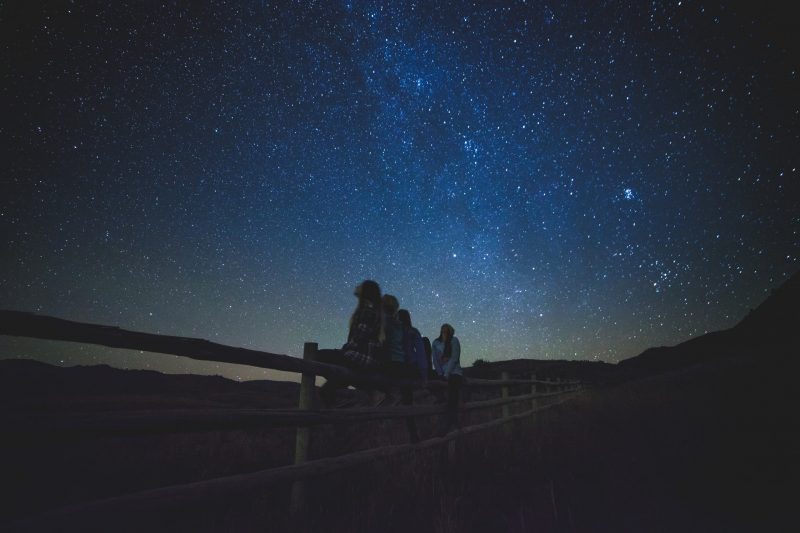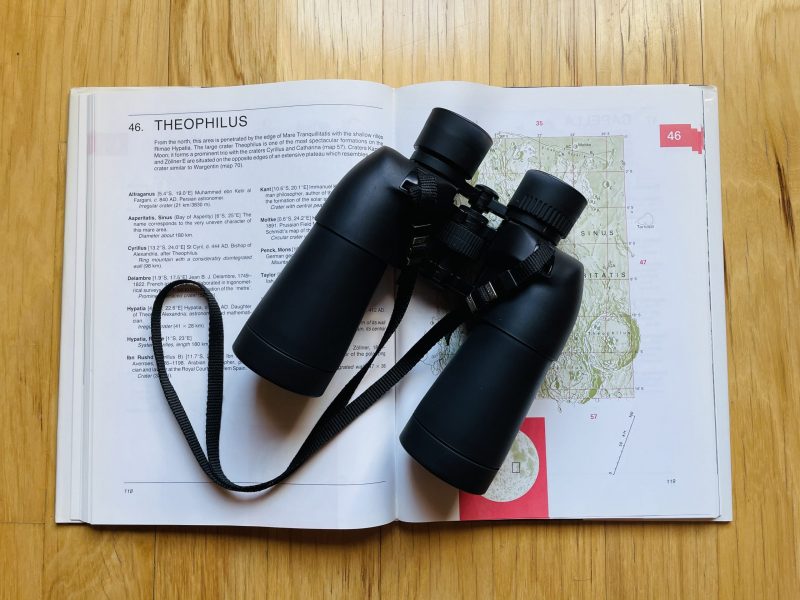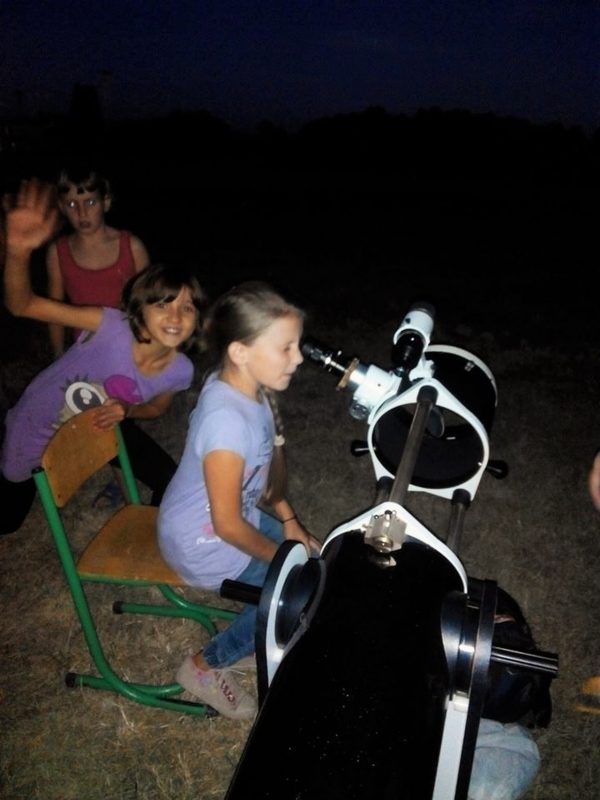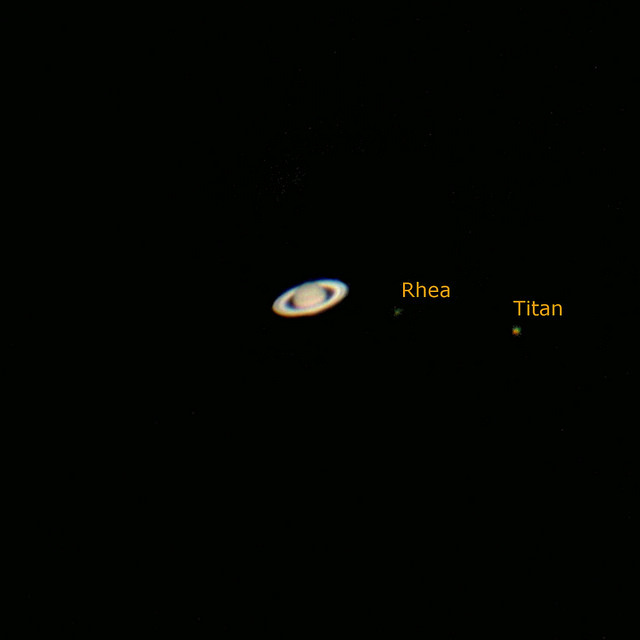

Should you buy a telescope? Maybe. If you’re familiar with the night sky and have needs beyond binoculars, then a telescope might be right for you. Image via Greg Rakozy on Unsplash.
Before you buy, ask yourself this question. Can you identify a few bright planets, and some bright stars and constellations? Buying a telescope is one thing; learning where and how to aim it is another. It’s fun to spend a year coming to know the stars and planets as they shift across Earth’s seasons. Do you need a telescope for that? Would binoculars be better?
It’s the wise beginner who spends a year with some simple star charts or a planisphere – and maybe a pair of binoculars – before investing in a telescope.
First binoculars for stargazing
The pro for binoculars is their ease of use. Most of us have already held and pointed binoculars at distant objects. For the beginning stargazer, a pair of 7×35, 8×40 or 7×50 binoculars is probably your best choice. The first number tells you the binoculars’ strength (magnification power) and the second the diameter of the objective lens, in millimeters. Binoculars can be used for stargazing up to a magnification of 10 without the support of a tripod. Binoculars will not show you meaningful detail on the planets, but they’ll bring out some detail on the moon, let you glimpse some of Jupiter’s moons and enhance the colors and brightnesses of sky objects. Binoculars are particularly useful for deep-sky observing of star clusters, nebulae and galaxies.
The con for binoculars is that, because they work so well for beginning deep-sky observing, stargazers enjoy them most when they have regular access to darker skies. What’s more, binoculars use complicated optics based on internal prisms that work to provide an erect image. With time – maybe a few years – the prisms may lose their factory-set alignment; additionally, in humid climates both the prisms and the lenses may start developing mold.
Luckily, binoculars are a smaller financial investment than telescopes. A reasonable budget for a beginner’s binocular can range from between about $100 and $200. Of course, you can spend more.
Read more: Top tips for binocular stargazing

Binoculars are perfect for the beginning stargazer because they’re reasonably priced, easy to use, and easy to transport. Image via Kelly Whitt.
Buying a beginner’s telescope
Once you know some bright stars and constellations, you’re ready to consider buying a telescope. Telescopes are either refractors (using lenses) or reflectors (using mirrors). Both are excellent.
If you want a refractor, consider a 3- to 4-inch (75- to 100-millimeter) long-tube achromatic refractor. Don’t confuse an achromatic refractor with an apochromatic; those two seemingly inconspicuous letters can make a huge difference in cost.
If you want a reflector, consider a 6- to 8-inch (150- to 200-millimeter) with a Dobsonian mounting. This type of mounting was popularized by John Dobson in the 1960s. It is easy to use and more portable than classical equatorial mounts. It is also cost-effective, giving you the best possible optical quality for the least money. Note, however, that Dobsonian mounts don’t use clock drives. To compensate for Earth’s spin, you have to “nudge” the telescope every few minutes along both axes to keep an object in view. Thus a Dobsonian mount is not the best for astrophotography; if that’s your primary goal, you’ll need an equatorial mount and a clock drive. On the other hand, if you want a solid first telescope for looking at and learning the sky – examining the planets and moon, perhaps even completing your first Messier marathon – a Dobsonian mount is for you. The budget for a reasonable beginner’s telescope with a Dobsonian mount might range between $300 and $600. As always, you can spend more.

Students in the Ukraine see the sky through a telescope for the 1st time. If you’re familiar with the constellations, you can help guide beginners across the sky after their first purchase of a telescope. Read more about this image from UNAWE.
Six more tips for first-telescope buyers
1. A beginner should be concerned more with aperture (tube diameter) than with magnifying power. The primary purpose of an astronomical telescope is to collect light; its magnifying power is a by-product. For example, a 6-inch (150-mm) telescope has twice the diameter of a 3-inch (75-mm) unit, meaning that its optical surface will be four times larger; in turn, this tells us that the 6-inch instrument will gather four times as much light as the 3-inch, making it four times more powerful. Given equal optical quality, a larger aperture may be preferable to a smaller one, if the budget allows.
2. Consider who will use the telescope, and how. Telescopes are big, bulky items that require setup each time you use them. Be sure to purchase a telescope that is not too heavy or bulky to use for the person who will be using it. Children and older stargazers, in particular, might have more fun with smaller, lighter instruments.
3. Spend at least a year just looking, and not taking pictures. Learning to see fine detail on planets and the moon, and in the vast array of object to be found in the deep sky, is an art. With practice, your eyes will learn to see. Budding astronomers will benefit from putting lots of time at the eyepiece. This implies that a first telescope should be optimized for visual astronomy and not photography.
4. Consider what else you need for an observing session. Many stargazers bring along lawn chairs, perhaps a small table to spread out your charts, a thermos of coffee, sandwiches. And, of course, you will need a red flashlight in order to read your charts without ruining your night vision.
5. Keep your expectations for a beginner’s telescope reasonable. Please drop the assumption that a planet will appear through your eyepiece as it looks on your wall poster! Also, forget about multi-colored nebulae. Light collected by a telescope is seen differently by cameras versus the human eye. All of that said, if you patiently train your eye to see – and allow yourself some visits to dark-sky locations – you might find yourself falling in love with the silence, the night air, and the wonder of peering upward, through a telescope, at the universe’s marvels.
6. Before and after you buy a telescope, connect with other amateur astronomers. Hook up with your local astronomy club, and take a peek through the eyepiece of every telescope that you encounter. Speak to the owners and ask them about the pros and cons. They will love to tell you about it. This will enable you to become familiar ahead of time with the basic setup and operation of an astronomical instrument. To find a group near you worldwide, visit this list at Skyandtelescope.com. For the U.S., visit this list from NASA.
Good luck and have fun!

Saturn’s large moon Titan, and its moon Rhea, imaged via iPhone and a Celestron NexStar 8SE telescope by Andrew Symes (@failedprotostar on Twitter). Thanks, Andrew! One of the most important things for beginner stargazers to remember is to adjust your expectations. Huge colorful photos of the planets from the Hubble Space Telescope are magnificent, but actually seeing the tiny planet with your own eyes is magical.
Bottom line: Binoculars are excellent for learning the sky, providing good views of solar system and deep sky objects for the astronomical beginner. When you finally go out for your first-ever telescope, keep it simple! Obtain either a 3- to 4-inch (75- to 100-millimeter) long-tube achromatic refractor, or a 6- to 8-inch (150- to 200-millimeter) Dobson-type reflector, with uncomplicated mechanics and few electronics. A telescope that is easy to set up, to use and to repair, is the key to a solid beginning in amateur astronomy.
Read more: Top tips for binocular stargazing
Source:
https://earthsky.org/astronomy-essentials/how-to-choose-1st-telescope-binoculars